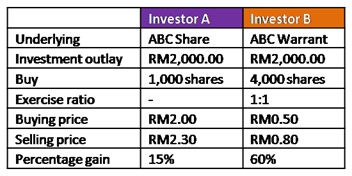The Risk of Investing in Warrants
- Home
- /
- Learning zone
- /
- Learn about Capital Market...
- /
- The Risk of Investing...
The Risk of Investing in Warrants
A warrant is an investment tool which provides opportunity for investors to diversify their investment. It is popular among retail investors, mainly due to its low cost investment and potential high return characteristics. This makes it even accessible to small investors who are without much additional capital.
However, many investors are investing into warrant without fully understanding the fundamental mechanics of how warrant works and the risk inherent in it. At the end of this article, you will be able to understand the basics of warrants and its implications on your investment decisions.
Types of warrants
A warrant gives you, as the buyer, the right but not the obligation, to buy or sell a specific number of the mother share or underlying shares at a specified price within a specific period. The holder of a warrant or call warrant will not have any voting or dividend rights as that enjoyed by shareholders. One of the main benefits of investing in a warrant is cost leveraging. When you invest in a warrant, you stand to gain from the exposure of the share price movement at only a fraction of its cost.
There are two types of warrants: call warrant and put warrant.

A call warrant is one that is most common in our local stock exchange and is almost similar to an option. A warrant is issued by the company of its underlying stock, while an option is a financial instrument of the stock exchange. Warrants are usually issued by companies as part of new issue offering to attract investors into buying the new security. A warrant is also considered a type of equity derivative as it derives its value from its underlying security.

Gearing effect
One of the reasons why warrant attracts investors is mainly because it costs only a fraction of the price of the underlying stock while offering relatively good return, either positive or negative.
Let’s take an example of ABC shares that are currently priced on the market at RM2.00 per share. Investor A puts in RM2,000 to purchase 1,000 shares. Investor B on the other hand, decides to invest the same capital of RM2,000 in warrants that was going for RM0.50 per warrant. With the same amount of investment, Investor B is in possession of 4,000 shares.
If ABC gains RM0.30 per share from RM2.00, to close at RM2.30, the percentage gain would be 15%. However, with a RM0.30 gain in the warrant, from RM0.50 to RM0.80, the percentage gain would be 60%.
This is the leveraging effect of warrant. However, the possibility of huge gain also comes hand in hand with huge loss.
During the life time of a warrant, it is also common that the price of warrant moves in parallel with the price of the underlying stock. Due to the leveraging effect, a small decline in the price of the underlying stock will result in a significant drop in the price of its warrant.


Risk control
Having such a high risk nature, investors who are interested in warrants must fully understand their own risk tolerance level. Too much exposure in warrant may subject their investment portfolio to excessive risk. Many investors tend to purchase warrants that are highly active in the market without much knowledge of what they are buying. As warrants are also popular among short-term speculators, an actively traded warrant may not be suitable for investors who intend to hold the warrant for a longer term. The amount could be provided by short-term traders who are speculating and attempting to earn short-term profit. Therefore, it is important for investors to pay attention to the type of market participants that are interested in the warrant.
Buying ITM warrants may offer less profit but lower risk compared to the OTM warrants. When a warrant is deeply OTM, it is less sensitive to the price movement of its underlying stock, which means even if the price of the stock increases, the price of its warrant may not have significant movement, as what we would expect out of a warrant that is near or in-the-money. Worst still, if the term of warrant is near to its maturity; its time value will decline drastically.
As in any other investment, investors should make sure that they fully understand the characteristics of warrant before they decide to invest in any of it.


